Team Yankee Analytics
By Howard West
I started playing in 2016 and attended my first tournaments in 2017. I had been playing for several years earlier and have been playing other miniatures games since the mid-seventies.
My first Team Yankee army was British and really enjoyed playing that army and decided to take it to two tournaments. In these tournaments, I faced five NATO opponents and one Warsaw PAC opponent. I played against two West German, two British, one American, and one Soviet opponent. At those two tournaments, the mix of armies entered was about 60-70% NATO vs the Warsaw Pact. Also at that time, the Oil Wars and Free Nations books had not been released.
Soon after playing in those two tournaments, one of the gamers at our local store put his partially painted Soviets up for sale and I scooped them up for a great price and had the basis for a decent starting Soviet Army. Fifty tournament games later I’m writing this article.
So, let’s start with the definition of Analytics. The Business Dictionary defines Analytic; as the study of past historical data to research potential trends.
In July 2018 I entered my new Soviet Army in its tournament. Before going to that tournament I had played multiple games at our local store with my Soviets but was unsure if my list would work in a tournament. My major concerns were could I get all of my reserves onto the board, did I need Anti Air support, and the various other questions that come up when you enter a tournament with a new army or an existing army.
My first Soviet Tournament List
Below is a pic of my new Soviet Army, the tournament was 4 rounds at 64 points. I played a BMP Battalion plus Support options. The BMP-2 Company, 2 BMP-1 Companies, BTR Company, 2 BMP-2 Recon, Storm, Spandrel, Carnation, Hail, Shilka, Gaskin, BMP-1 Commander and BMP-1 OP.
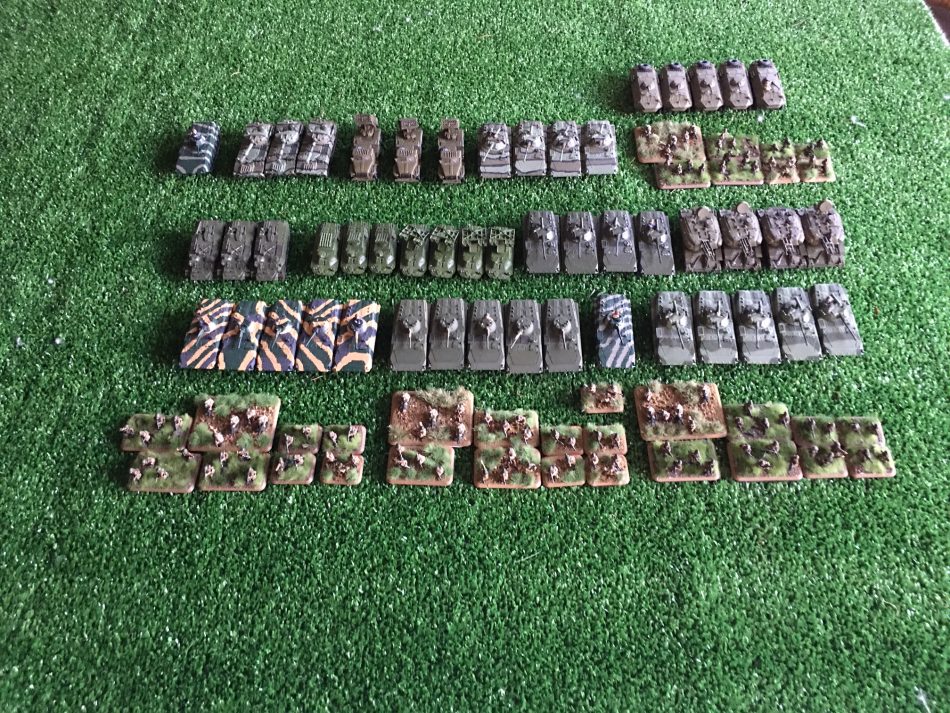
To answer those types of questions, I started writing down some simple consistent notes about each of my games. The following is what I have collected for each of my Team Yankee tournament games since 2018:
- What was the mission?
- Did I attack or defend?
- What was the opponent’s army’s nationality?
- Did the opponents have air?
- What was the # of points used?
I also write down a quick note on what they played Ex: American ACR, M-60. That is far as I go on my opponent’s list. I really do not want to dig deeper into their list, for my example, it does not matter if they had 4 M-60s or 12 M-60s in their American ACR List.
Point of reference for the charts and graphs that follow are based on the notes that I have collected over the past 50 Team Yankee tournament games. I played various Soviet lists 41 times and East German lists 9 times. The games were played from July 2018 thru August 2020. I also keep a copy of each of the lists that I used for future reference.
What was the mission?
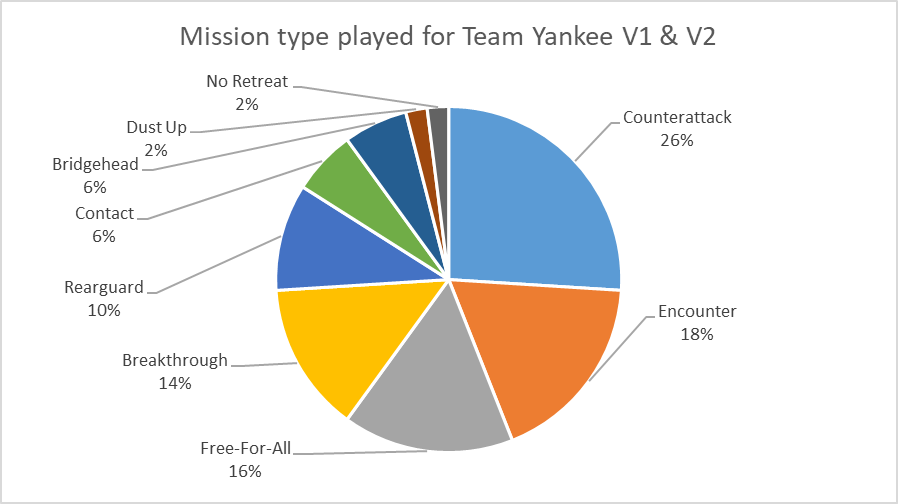
Based on the above data, if I wanted to get in any practice games before my next tournament I probably should practice Counter Attack, Encounter, Free for All, or Breakthrough. They account for 74% of the games that I have played.
List construction: If you assume that the above mission trend continues, only 18% of the missions had a chance for deep reserves. This information may help in future list design.
Note: The More Missions Book was used for all of the above games. In some cases, the Tournament Organizer (TO) may limit the number of Attack, Defend or Maneuver stances for each tournament or may provide the Missions. EX: The TO may limit you to two attack selections. At a recent tournament the TO provided the missions ahead of time, the players still rolled to determine who the attacker or defender was.
Did I Attack or Defend?
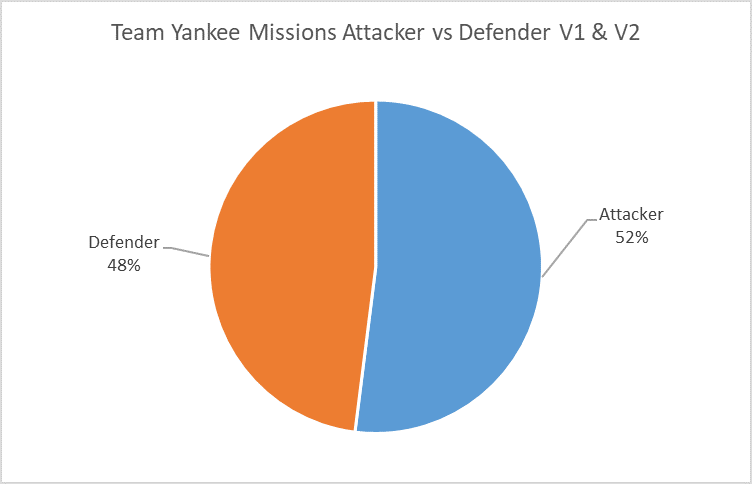
This chart really surprised me that after 50 games I attacked and defended nearly the same number of games. With the additional data point of that only 18% of the missions had deep reserves. I may want to consider a more tank heavy force.
After seeing the Attacker/Defender chart, I went back and looked at the raw data again and noticed that I was the net defender in the majority of the meeting type engagements.
Opponent’s nationality?
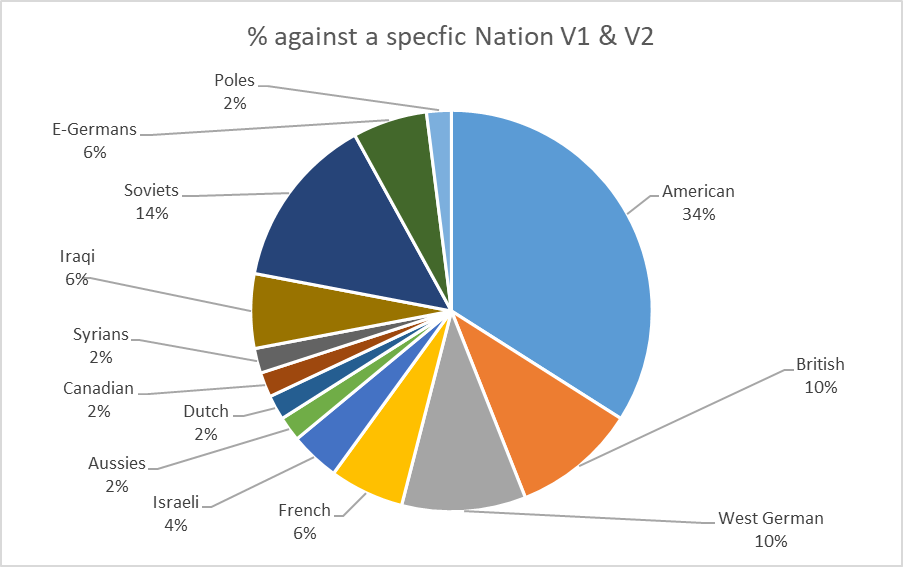
Based on the location of the tournaments that I have entered, the entry still leans very heavily towards NATO. Since my decision to migrate from playing my British army to Soviets in 2018, thru 2021, and East Germans in 2020, 2021. I have faced NATO opponents 78% of the time and Warsaw Pact opponents 22% of the time, this knowledge has defiantly helps me with list construction. In 2021 I think you might see the above mix change especially with the new American and Soviet books being available and the new West German and Warsaw Pact books for Team Yankee later in 2021. On the other hand, I have not seen an increase in the percentage of opponents playing British.
Did the opponent have Air?
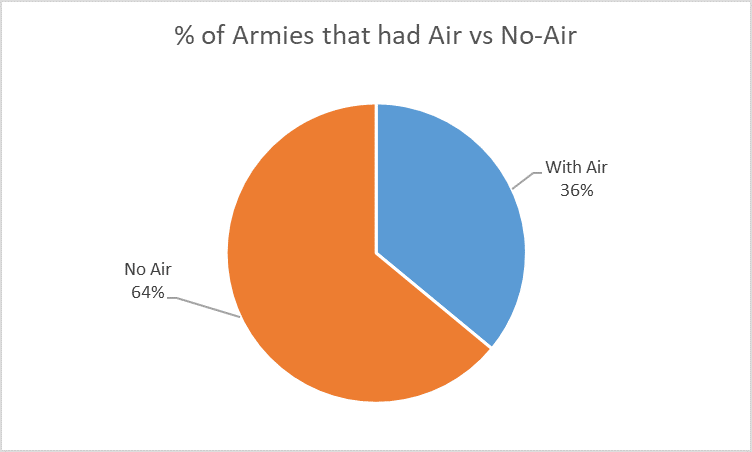
To a certain extent, the above number surprises me. Currently, I plan on players having Air in their lists. In the summer of 2019, I entered a 4 round tournament, and based on the points used, I decided to remove one of my Soviet Shilka units. In my first game, my opponent had 4 A-10s and my 2nd opponent had 20 Hinds, he had a Syrian Army with a Soviet Air Assault Allied Formation. Needless to say, the 2nd Shilka unit went back into all of my future lists. I think the percent using air will increase over time as existing Team Yankee players use some of the new heavier tanks and new players starting out using the new starter sets. This may result in more players using Air in their lists to counter the new heavier tanks. The second point to consider is that the opponent may also realize this and has reduced or eliminated their anti-air units.
Note: Air is both Airplanes and Attack Helicopters.
# of points used for each Tournament?

The 50 games that have been played came from 16 tournaments. The 120 point number would have been higher, due to having multiple tournaments canceled due to COVID-19 in 2020.
My sixteenth tournament list:
Below is a pic of my East German Army list, the tournament was 3 rounds at 120 points and the TO provided the missions that would be fought. I played a BMP Battalion plus Support options and a Soviet T-64 Allied Formation. The army consisted of: BMP-2 Company, 2 BMP-1 Companies, BMP-1 Recon, Carnation, Shilka, Gaskin, BMP-1 Commander Hail, and BMP-1 OP. Soviet Allied T-64 Formation consisted of: 2-T64 Companies, Shilka, BRDM Platoon and a T-64 Commander.
 Next Steps:
Next Steps:
Since after each tournament I update the master Excel spreadsheet, I plan on updating this document after the next 25 to 30 gave have been played. Also, I have been playing around with the idea of opponents played chart mapped to various book releases. EX: How many American opponents before and after the release of the New American Book.
Summary:
Collecting the data and storing it in something like Excel was pretty easy, you do not need to be an Excel guru to build the charts and graphs that I have enclosed. The collected data and the results from the analysis of that data have helped me construct better lists. This same approach could be used for Flames of War. One thing to remember is that your results will vary based on what your opponents are playing in your geographical area. Good luck with your Team Yankee Analytics.

Great article Howard,,,, We need to sign you up!
Thanks Mitch
Good job, Howard! In all those tournaments I don’t think I ever played against you.
Nope but I drove you to many of them.
Excellent article. Thanks for the analytics. Have played as West Germans since it came out and was looking to see the viability of a Soviet force. This gives me comfort to jump in.
Tim Thanks for the comments, I think the Warsaw Pact and Soviet lists are really fun to play. It will be interesting to see how the balance of armies played at tournaments will change after the new West German and Warsaw Pact books come out. I have a West German army painting project that I have been working on for about 2 years now and play it locally and really like it but my go to tournament armies are Soviets and East Germans. I really like the fact that I can go to a tournament and almost 80% of the time I will get a Red vs Blue matchup.
Thank you Howard. That was a great article and I love the subject matter.
Good stuff Howard. Thanks for posting.
The mason breakdown chart begs some questions. Did you have a mission stance as a constant? Do you have the statistics for how many times you played A/M/D? Perhaps a more accurate chart would be missions played by battle plan.
I commend you for the discipline to record the data every game. I can barely remember to bring the right minis with me to a tournament!
Scott Thanks for the comments, especially the memory one. What stance do I pick? This really come down to how the tournament organizer(TO) sets up the tournament, recently we have had several that you can only attack, maneuver or defend once in a 3 round tournament. Or the TO provided the missions for each round before the tournament. Since I know how the TO has setup the tournament that may effect how I build my list. EX: If a TO says that one of the missions will be Bridgehead or No Retreat and it is a dice off to see who attacks or defends some of my tanks might stay at home to avoid deep reserves. If I’m playing a BMP heavy list, I want to Attack or Maneuver. I’m also constantly tweaking my lists to see if a list could defend or attack better. So after all of this has been sorted out before game day and I would probably lead with an Attack in round one and based on the mission matrix results that helps lead to the top four missions that I have played.
Howard, awesome stats! Did you track wins vs losses for each round or tourney? That would be interesting to see.
Dan Thanks for the comments. I have the data, since I write my notes down on the back of my army list as Game #1, Game #2, Game #3. I have a table and chart already that tracks my results, this was not part of the article. I think your stance selection does change in the 3rd or 4th round and the weariness sets in and you do not really take the time to think what is the best stance to pick.
In my larger European region, TY tournaments disappeared entirely due to the overwhelming strength of T55/BMP spamlists, be it Czech or NVA. T1 MBT lists usually vanish facing them, but apparently this is not an issue in the US-leaning US..
In the part of the US that I travel to for tournaments, I have not really seen that many T-55 or BMP spam lists. Some of my opponents might think some of my BMP lists might qualify as spam lists. This might change with the new and improved Soviet T-55s in the new Soviet book.
Very interesting!l article!
Did you have a preferred stance?
Why did you switch from Russians to East Germans?
Owen Thanks for the comments. I switched mainly for the improved Skill to range in Artillery and Blitz especially after V2 came out. I had added a East German allied formation first of T-72s and T-55s to my base Soviet list in V1, that was before the T-62M arrived. Currently the list is a East German BMP formation with some sort of Soviet BMP(BMP-2 or BMP-3) or Tank formation(T-62M) added as my 2nd formation. This combo works pretty good, especially after the new Soviet book came out with the improved RPG’s.